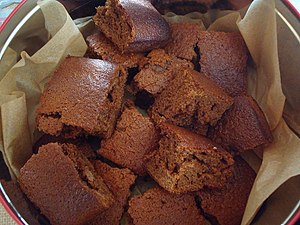Parkin (cake)

Yorkshire parkin
|
|
| Alternative names | Perkin |
|---|---|
| Place of origin | England |
| Region or state | Northern England - Lancashire, Yorkshire |
| Main ingredients | Flour, oatmeal, molasses, lard or butter |
| |
|
Parkin or Perkin is a gingerbread cake traditionally made with oatmeal and black treacle, which originated in northern England. Often associated with Yorkshire, particularly the Leeds area, it is very widespread and popular elsewhere, notably in Lancashire. Parkin is baked to a hard cake but with resting becomes moist and even sometimes sticky. In Hull and East Yorkshire, it has a drier, more biscuit-like texture than in other areas. Parkin is traditionally eaten on Guy Fawkes Night, 5 November, but is also enjoyed throughout the winter months. It is baked commercially throughout Yorkshire, but is mainly a domestic product in other areas.
The origin of the word parkin is unknown. The first published dated reference to parkin was collected from 1728 from the West Yorkshire Quarter Sessions when Anne Whittaker was accused of stealing oatmeal to make parkin. The Lancashire weaver Tim Bobbin describes tharf cake in 1740- and this is recognisable as a parkin. A possible older use of parkin is in the seventeenth century ballad 'The song of Arthur O'Bradley' that purports to describe a merry wedding from the time of Robin Hood (fourteenth century)
The tharf cake is of ancient Teutonic origin, as tharf or theorf meant unleavened, un-fermented, solid tough or sodden in Old English. John Wycliffe in his translation of the Bible in 1389 (Mark Ch.14.v. 1) calls unleavened bread a 'tharf loove'
Parkin is virtually unknown south of the Humber. It is eaten in an area where oats were the staple grain for the poor, rather than wheat. It is closely related to tharf cake - an unsweeted cake cooked on a griddle rather than baked. The traditional time of the year for tharf cakes to be made was directly after the oat harvest in the first week in November. For festive occasions, the cake would be sweetened with honey. In the seventeenth century (about 1650) sugar started to be imported from Barbados- and molasses was a by-product of the refining process. Molasses was first used by apothecaries; to make a medicine theriaca, from which name the word treacle is derived. As molasses became plentiful, or treacle as it became called at that time, it was substituted for honey in the preparation of tharf cakes.
...
Wikipedia
